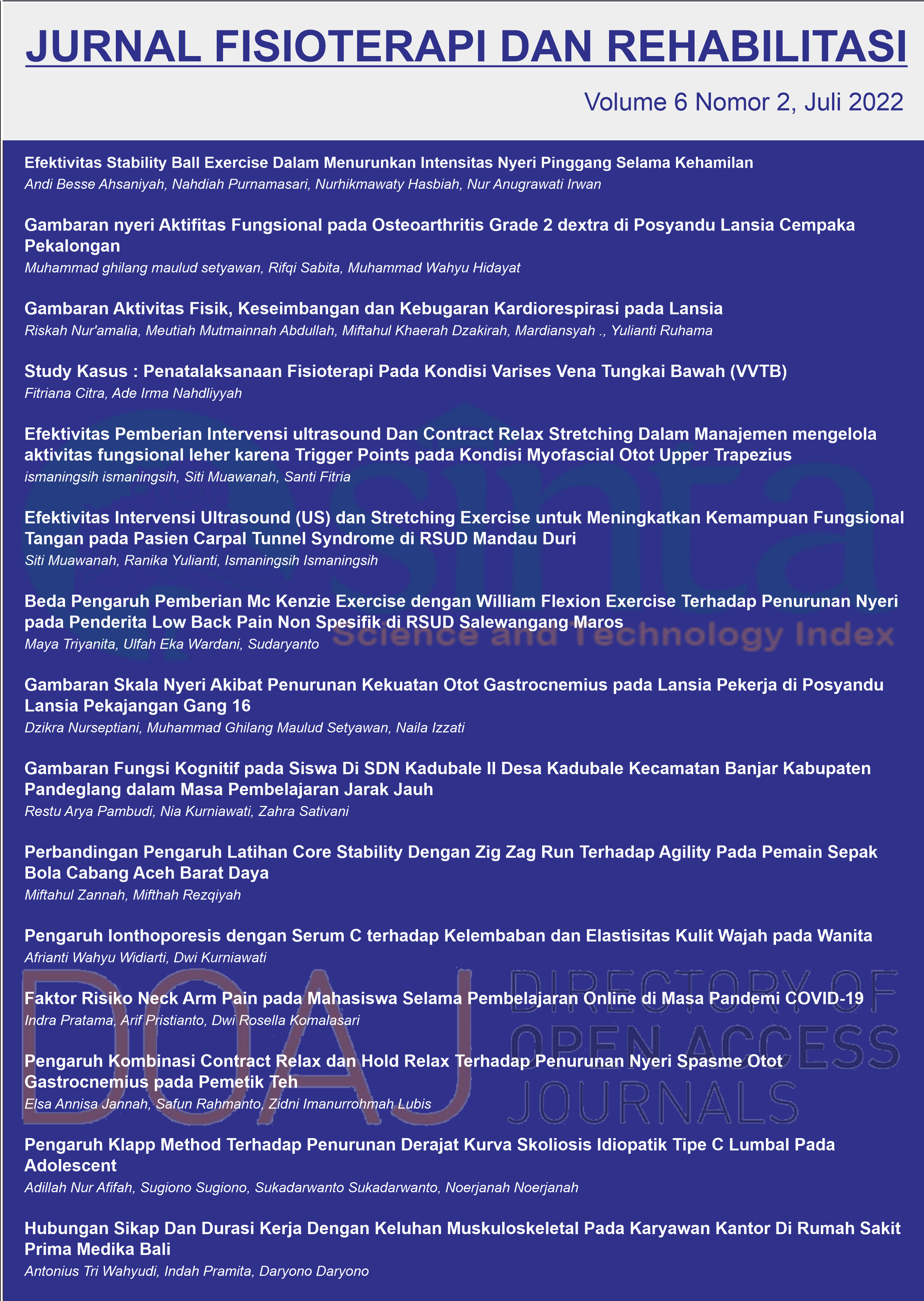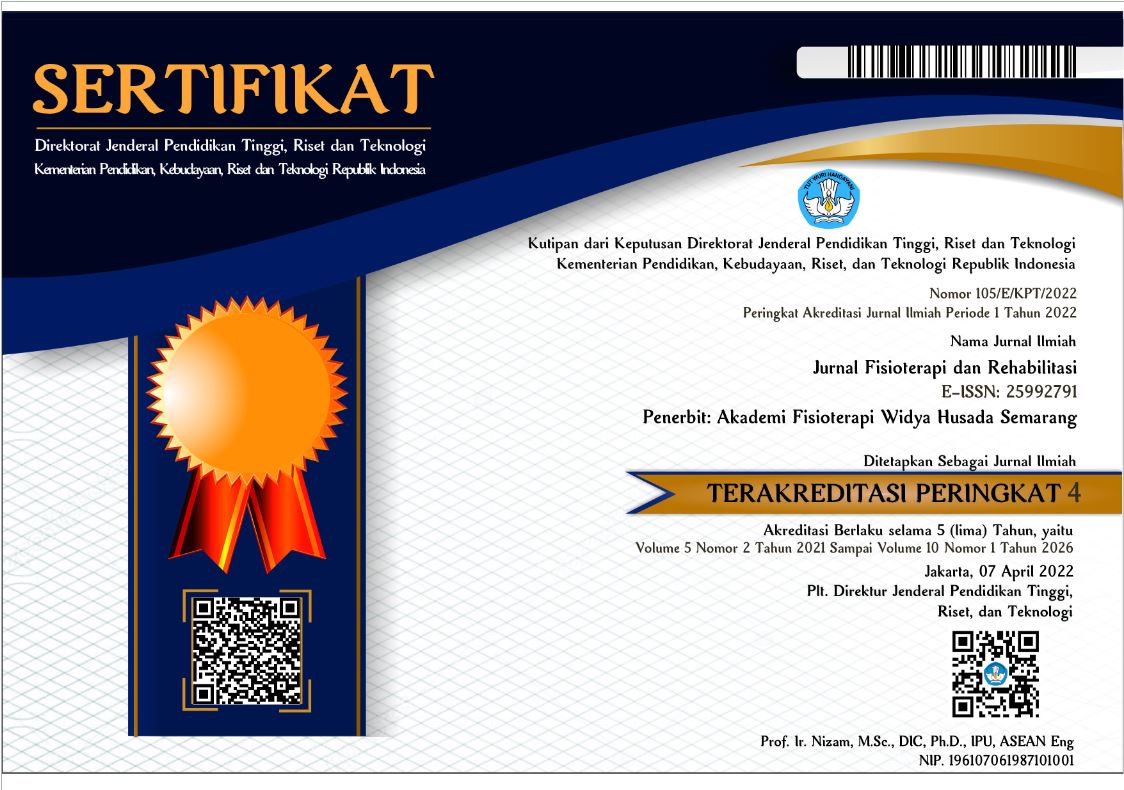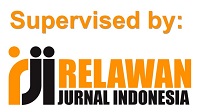Hubungan Sikap Dan Durasi Kerja Dengan Keluhan Muskuloskeletal Pada Karyawan Kantor Di Rumah Sakit Prima Medika Bali
Relationship between Attitude and Work Duration with Musculoskeletal Complaints in Office Employees At Prima Medika Hospital Bali
Abstract
Karyawan kantor di RS Prima Medika melakukan aktivitas pekerjaan dengan sikap kerja duduk statis. Sikap ini dipertahankan selama bekerja kurang lebih dari 4 jam sampai dengan 8 jam lebih. Sikap kerja duduk dalam waktu yang lama dengan leher dan punggung tidak dalam posisi ergonomis mengakibatkan pemendekan pada otot-otot skeletal, hal ini dikarenakan terjadinya reaksi ketegangan atau kontraksi dalam jangka waktu yang panjang sehingga apabila terjadi secaara terus menerus dapat menyebabkan keluhan pada otot-otot yang mendapat beban. Metode penelitian ini adalah metode Cross Sectional dengan menggunakan responden sebanyak 27 orang karyawan kantor RS Prima Medika yang didapat berdasarkan kriteria penelitian. Alat ukur pada penelitian ini adalah Rapid Entire Body Assessment untuk mengukur sikap kerja dan lembar kuesioner Nordic Body Map untuk mengukur keluhan muskuloskeletal dari responden. Hasil pengukuran selanjutnya dilakukan uji hipotesis dengan menggunakan Spearman’s Rho Test. Hasil Spearman’s Rho Test menunjukkan nilai signifikasi 0,990 dan nilai korelasi 0,003 antara sikap kerja dengan keluhan muskuloskeletal dan nilai korelasi 0,068 dan nilai signifikasi 0,737 antara durasi kerja dengan keluhan muskuloskeletal. Hasil ini menunjukkan bahwa korelasi sikap kerja dan durasi kerja dengan keluhan muskuloskeletal memiliki hubungan searah yang sangat lemah dan tidak signifikan
Downloads
References
Coenen, P., Parry, S., Willenberg, L., Shi, J. W., Romero, L., Blackwood, D. M., ... & Straker, L. M. (2017). Associations of prolonged standing with musculoskeletal symptoms—a systematic review of laboratory studies. Gait & posture, 58, 310-318. Sadler, S., Cassidy, S., Peterson, B., Spink, M., & Chuter, V. (2019). Gluteus medius muscle function in people with and without low back pain: a systematic review. BMC musculoskeletal disorders, 20(1), 1-17.
Frey, M., Poynter, A., Younge, K., & De Carvalho, D. (2019). The relationship between lumbopelvic flexibility and sitting posture in adult women. Journal of biomechanics, 84, 204-210.
Jung, K. S., Jung, J. H., In, T. S., & Cho, H. Y. (2021). Effects of Prolonged Sitting with Slumped Posture on Trunk Muscular Fatigue in Adolescents with and without Chronic Lower Back Pain. Medicina, 57(1), 3.
Pratama, D. N. (2017). Identifikasi Risiko Musculoskeletal Disorders (MSDs) Pada Pekerja Pandai Besi. The Indonesian Journal of Occupation Safety and Health. 6(1). P.78. Doi: 10.20473/Ijosh.V6i1.2017.78-87.
Prawira, M. A., Yanti, N. P. N., Kurniawan, E., & Artha, L. P. W. (2017). Factors related musculoskeletal disorders on students of Udayana University on 2016. Journal of Industrial Hygiene and Occupational Health, 1(2), 101- 118.
Singh, S., Grover, V., & Singh, S. (2015). Effect of neural mobilization and PNF stretching on hamstring flexibility in working women. International journal of health sciences and research, 5(8), 361-368.
Yosineba, T. P., Bahar, E., Adnindya, M. R. (2020). Risiko Ergonomi dan Keluhan Muskuloskeletal Disorders (MSDs) pada Pengrajin Tenun di Palembang. Jurnal Kedokteran dan Kesehatan: Publikasi Ilmiah Fakultas Kedokteran Universitas Sriwijaya. 7(1). Pp. 60-66. Doi: 10.32539/Jkk.V7i1.10699.
Youdas, J. W., Hartman, J. P., Murphy, B. A., Rundle, A. M., Ugorowski, J. M., & Hollman, J. H. (2015). Magnitudes of muscle activation of spine stabilizers, gluteals, and hamstrings during supine bridge to neutral position. Physiotherapy theory and practice, 31(6), 418-427.

This work is licensed under a Creative Commons Attribution 4.0 International License.
The use of the article will be governed by the Creative Commons Attribution license as currently displayed on Creative Commons Attribution 4.0 International License.
Author’s Warranties
The author warrants that the article is original, written by stated author(s), has not been published before, contains no unlawful statements, does not infringe the rights of others, is subject to copyright that is vested exclusively in the author and free of any third party rights, and that any necessary written permissions to quote from other sources have been obtained by the author(s).
User Rights
JFR's spirit is to disseminate articles published are as free as possible. Under the Creative Commons license, JFR permits users to copy, distribute, display, and perform the work. Users will also need to attribute authors and JFR on distributing works in the journal.
Rights of Authors
Authors retain all their rights to the published works, such as (but not limited to) the following rights;
- Copyright and other proprietary rights relating to the article, such as patent rights,
- The right to use the substance of the article in own future works, including lectures and books,
- The right to reproduce the article for own purposes,
- The right to self-archive the article
Co-Authorship
If the article was jointly prepared by other authors, any authors submitting the manuscript warrants that he/she has been authorized by all co-authors to be agreed on this copyright and license notice (agreement) on their behalf, and agrees to inform his/her co-authors of the terms of this policy. JFR will not be held liable for anything that may arise due to the author(s) internal dispute. JFR will only communicate with the corresponding author.
Miscellaneous
JFR will publish the article (or have it published) in the journal if the article’s editorial process is successfully completed. JFR's editors may modify the article to a style of punctuation, spelling, capitalization, referencing and usage that deems appropriate. The author acknowledges that the article may be published so that it will be publicly accessible and such access will be free of charge for the readers as mentioned in point 3.












